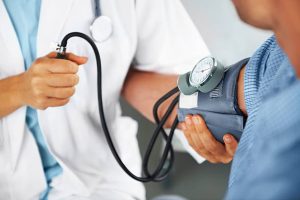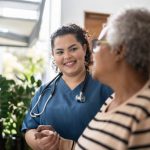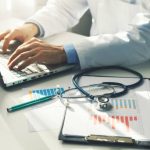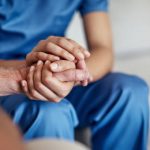Physical Address
A sleep study, also known as polysomnography, is a type of test that is used to diagnose sleep disorders. Through this study, healthcare providers can gather information about a person’s brain activity, heart rate, oxygen levels, and movement during their sleep.
During a sleep study, the patient spends one or more nights in a sleep lab, where healthcare providers attach various wires and sensors to them. These are used to monitor and record data while the person is asleep. Some of the common measurements taken during a sleep study include brain waves, eye movements, heart rate, leg movements, and snoring episodes.
Sleep studies can help identify and diagnose various sleep disorders such as sleep apnea, insomnia, narcolepsy, restless legs syndrome, and bruxism. They can also determine the severity of these conditions and assess the efficiency of a person’s sleep.
If you have symptoms such as excessive daytime sleepiness, difficulty falling asleep or staying asleep, loud snoring, or regular episodes of waking up gasping for air, your healthcare provider may recommend a sleep study to evaluate your sleep health. A sleep study can provide valuable information that can affect your overall health and well-being.
So, if you are experiencing any sleep-related issues, don’t hesitate to discuss them with your healthcare provider. They can determine whether a sleep study might be beneficial for you and recommend the appropriate course of action to help improve your sleep quality and overall health.
What is it used for
Polysomnography, also known as a sleep study, is used to diagnose sleep disorders. It is a test that records your body’s activity while you sleep. During a sleep study, you will spend a night in a hospital or sleep center, where various sensors and electrodes will be attached to your body with wires.
The sensors will monitor your heart rate, brain waves, oxygen levels, and leg movements, among other things. This information is then used by healthcare providers to help diagnose conditions such as sleep apnea, insomnia, narcolepsy, and bruxism.
Sleep apnea is a condition where you temporarily stop breathing during sleep, causing episodes of shallow or paused breathing. Insomnia is a sleep disorder characterized by difficulty falling asleep or staying asleep. Narcolepsy is a neurological disorder that affects the control of sleep and wakefulness, causing excessive daytime sleepiness. Bruxism is the involuntary grinding or clenching of teeth during sleep.
A sleep study can also help determine the severity of these conditions and recommend appropriate treatment options. It can provide valuable information about your sleep patterns and quality, which can affect your overall health and well-being.
If you have symptoms such as loud snoring, gasping for air during sleep, excessive daytime sleepiness, or leg movements during sleep, your healthcare provider may recommend a sleep study to evaluate your sleep and provide appropriate treatment.
Overall, sleep studies are vital in diagnosing and treating various sleep disorders, allowing healthcare providers to understand the underlying causes and recommend appropriate interventions to help individuals get a better night’s sleep.
Why do I need a sleep study
A sleep study, also known as polysomnography, is a test performed at a hospital or sleep center to evaluate your sleep patterns. It involves spending one or more nights at the facility while your sleep is monitored. You may wonder why you would need a sleep study and what it can tell you about your health.
One common reason for a sleep study is excessive daytime sleepiness. If you regularly feel tired or sleepy during the day, despite getting a full night’s rest, a sleep study can help determine if a sleep disorder is causing your sleepiness. Sleep disorders such as sleep apnea, restless legs syndrome, or bruxism (teeth grinding) can significantly affect your sleep quality and contribute to daytime sleepiness.
Healthcare providers may also recommend a sleep study if you have symptoms such as frequent awakenings during the night, snoring, or gasping for breath during sleep. These symptoms could indicate sleep apnea, a condition where your breathing is repeatedly interrupted during sleep, leading to poor sleep efficiency and decreased oxygen levels.
A sleep study can also help diagnose other conditions that may affect your sleep patterns. For example, it can detect abnormal brain activity during sleep, which may suggest a seizure disorder. It can also identify abnormal leg movements, indicating restless legs syndrome or periodic limb movement disorder.
During a sleep study, various sensors and wires will be attached to different parts of your body to monitor different aspects of your sleep. These sensors will measure brain activity, eye movement, heart rate, oxygen levels, and muscle activity. The data collected from these sensors will be analyzed by sleep specialists to provide a comprehensive evaluation of your sleep.
If you’re experiencing sleep-related issues that affect your daily life, don’t hesitate to discuss a sleep study with your healthcare provider. It can provide valuable insights into your sleep patterns and help diagnose underlying conditions that may be affecting your sleep and overall health.
What happens during a sleep study
A sleep study, also known as polysomnography, is a test that measures different aspects of your sleep to help diagnose sleep disorders and assess your overall health during the night. During the study, you will spend one or more nights in a sleep laboratory or a hospital.
Preparation
Before the sleep study, your healthcare provider will recommend certain things to prepare for the procedure. For example, they may advise you not to consume caffeine or alcohol on the nights leading up to the study. They may also ask you to avoid napping during the day and to bring comfortable sleepwear to the sleep center.
The study
During the sleep study, small sensors and electrodes will be attached to various parts of your body, such as your head, face, chest, legs, andor finger. These sensors will record your brain waves, eye movements, heart rate, oxygen levels, leg movements, and other parameters throughout the night. You may also be asked to wear a belt to measure your breathing.
While you sleep, the sensors will gather data about your sleep patterns, the quality of your sleep, any abnormal brain activities, episodes of sleep apnea, heartbeats, and any leg movements. This information will then be analyzed by sleep specialists to help diagnose any sleep disorders or other health issues that may be affecting your sleep.
Helping you fall asleep
If you have trouble falling asleep in a new environment, the sleep center staff can provide assistance. They may recommend certain relaxation techniques or play soft music to help you relax. You can also bring your own pillow or blanket to make yourself more comfortable. In some cases, sleep medications may be prescribed to help you fall asleep.
It’s important to try to sleep as naturally as possible during the sleep study. Although the wires attached to you may feel strange, the sleep center staff will try to minimize any discomfort. They will also ensure that the wires are securely attached to prevent them from coming off during the night.
Bruxism monitoring
If you have a history of grinding your teeth or suspect that you may have bruxism, additional sensors may be placed near your jaw muscles to monitor your jaw movements during sleep. This can help diagnose and assess the severity of bruxism.
Overall, a sleep study is a valuable tool for healthcare providers to assess your sleep health and diagnose any sleep disorders or related health issues. It can provide important insights into your sleep efficiency, brain activities, sleep apnea, and other conditions that may be affecting your sleep quality. Following the sleep study, your healthcare provider can recommend appropriate treatments or lifestyle changes to improve your sleep and overall health.
Will I need to do anything to prepare for the test
Before undergoing a sleep study, there are a few things you may need to do to prepare for the test. Your healthcare provider will provide you with specific instructions based on your individual situation, but here are some general guidelines:
1. Avoid consuming caffeine or alcohol: It is best to refrain from consuming caffeine or alcohol on the day of your sleep study, as these substances can affect your sleep quality and may interfere with the accuracy of the test results.
2. Take your medications as usual: Unless your healthcare provider instructs otherwise, continue taking any prescribed medications as usual. It is important to inform your provider of all the medications you are currently taking, as some medications may affect the results of the study.
3. Follow your usual sleep routine: In the days leading up to the sleep study, try to maintain your typical sleep schedule. This will help ensure that the results accurately reflect your usual sleep patterns.
4. Avoid napping: If possible, avoid taking daytime naps on the day of the study. Napping can make it more difficult for you to fall asleep during the study and may affect the results.
5. Shower before the test: It is recommended to take a shower before coming to the sleep study. This will help ensure that the electrodes and other sensors used during the study adhere properly to your skin for better signal quality.
6. Talk to your provider about any specific concerns: If you have any specific concerns or conditions, such as bruxism, restless legs syndrome, or sleep apnea, discuss them with your healthcare provider before the study. They may recommend additional measures or provide specific instructions to address these issues.
By following these preparation guidelines, you can help ensure the accuracy and efficiency of your sleep study. Remember to arrive at the sleep lab or hospital on time and be prepared to spend the night in a sleep-friendly environment. The sleep study, also known as polysomnography, typically involves the attachment of numerous wires and sensors to monitor brain activity, heart rate, breathing, eye movements, oxygen levels, and leg movements during sleep. Even though these wires may seem uncomfortable, the technicians will do their best to make you as comfortable as possible. They will provide you with instructions on how to move around during the night without disturbing the wires.
It is important to note that sleep studies are conducted to diagnose various sleep-related disorders, such as sleep apnea, insomnia, narcolepsy, and restless legs syndrome, among others. If you experience symptoms such as excessive daytime sleepiness, loud snoring, breathing pauses during sleep, or leg movements that disrupt your sleep, your healthcare provider may recommend a sleep study to evaluate your sleep health and help determine the most appropriate treatment plan for you.
Are there any risks to the test
Polysomnography, or sleep study, is a safe and non-invasive test that is commonly used to diagnose sleep disorders. While there are generally no significant risks associated with the test, there are a few minor risks and discomforts that can occur during the procedure.
One of the most common discomforts is the placement of electrodes and wires on the scalp and other parts of the body. These electrodes and wires are used to monitor brain activity, eye movements, muscle tone, and heart rhythm during sleep. Though the process of attaching these electrodes and wires may take some time and can cause mild discomfort, it is generally well-tolerated by most patients.
Some patients may experience difficulty falling asleep or staying asleep during the sleep study. This can be due to the unfamiliar environment of the sleep laboratory, the presence of the electrodes and wires, or simply the anxiety and anticipation of the test itself. However, sleep technicians and healthcare providers are usually understanding and will do their best to help patients feel relaxed and fall asleep.
In rare cases, the sleep study may reveal episodes of sleep apnea or other significant sleep disorders that require immediate medical attention. This can be a serious health concern, as sleep apnea can affect oxygen levels and may have implications for heart health. If these episodes occur during the sleep study, the healthcare providers present will act promptly to provide appropriate medical intervention.
Some patients may experience discomfort or sensations such as leg cramps or restless legs during the sleep study. This is more common in those who already have these conditions or are prone to them. Providers will typically recommend that patients discuss any relevant health conditions or symptoms, such as bruxism (teeth grinding), with them prior to the test, in order to ensure their safety and comfort during the study.
Overall, the risks associated with a sleep study are minimal compared to the potential benefits. The information gathered from the test can help healthcare providers diagnose and treat sleep disorders, improve sleep quality, assess the efficiency of breathing and oxygen levels during sleep, and/or evaluate the effectiveness of certain treatments or therapies.
What do the results mean
After conducting a sleep study, the results can provide valuable information on various aspects of your sleep patterns and health. These results can help diagnose and understand any sleep-related disorders or issues you may be experiencing.
The sleep study measures different parameters throughout the night, such as the number of episodes of interrupted sleep, the level of oxygen in your blood, and the efficiency of your sleep. It also monitors activities in your brain and heart, as well as any movements or abnormalities that occur during sleep.
If the results show a high number of interrupted or fragmented episodes during the night, it could indicate that you have a sleep disorder such as sleep apnea. Sleep apnea is a condition where you repeatedly stop breathing during sleep, leading to disrupted sleep patterns and low oxygen levels.
The oxygen level readings can help determine if there are any issues with your breathing or if you have a condition that affects your oxygen intake during sleep. Low oxygen levels may indicate sleep apnea or other respiratory problems.
Providers will also look for signs of bruxism, a condition where you grind or clench your teeth during sleep. This can be detected through the monitoring of muscle activity in the jaw and face.
In some cases, providers may recommend additional tests or interventions based on the results of the sleep study. These may include further assessments, such as a multiple sleep latency test to evaluate daytime sleepiness, or a portable sleep monitor to gather additional data.
If the results indicate sleep-related issues or disorders, providers may recommend treatments or interventions to help improve sleep quality and overall health. This could include lifestyle changes, medication, or the use of devices such as Continuous Positive Airway Pressure (CPAP) machines.
It is important to note that the results of a sleep study should be interpreted by a healthcare professional who specializes in sleep medicine. They have the expertise to analyze the data and provide an accurate diagnosis and appropriate recommendations for treatment.
Overall, the results of a sleep study can provide valuable insight into your sleep patterns, efficiency, and potential health issues. By identifying and addressing any sleep-related problems, you can improve your overall well-being and quality of life.
Is there anything else I need to know about a sleep study
During a sleep study, you may be asked to stay overnight at a sleep center or hospital. The main purpose of the sleep study, or polysomnography, is to diagnose sleep disorders and assess the efficiency and quality of your sleep. However, there are some additional things you should know about sleep studies.
- Sleep studies may also be recommended for individuals who have other conditions that can affect sleep, such as heart or lung problems.
- During the study, various sensors and wires will be attached to your body to monitor different aspects of your sleep. Don’t worry, the wires are not painful and are usually well-secured.
- Some sleep studies may require multiple nights to gather enough data. Your healthcare providers will let you know beforehand if this is the case.
- It is important to try to sleep as naturally as possible during the study, despite the presence of the sensors and wires. Try not to focus too much on them and instead focus on trying to fall asleep.
- The sleep study will monitor your brain waves, heart rate, oxygen levels, and other physiological parameters to help diagnose any sleep disorders, such as sleep apnea or insomnia.
- If you experience any unusual episodes during the study, such as leg movements or bruxism (teeth grinding), be sure to mention them to the healthcare professionals conducting the study.
- After the sleep study, the recorded data will be analyzed by trained professionals to interpret the results. This analysis will help your healthcare providers develop a treatment plan tailored to your specific needs.
- Sleep studies do not typically diagnose sleepiness or determine if you are getting enough sleep. These conditions are more subjective and may require additional assessments.
Overall, a sleep study is an important tool for assessing your sleep health. It can provide valuable information about the quality of your sleep and help identify any underlying sleep disorders that may be affecting your overall well-being.









